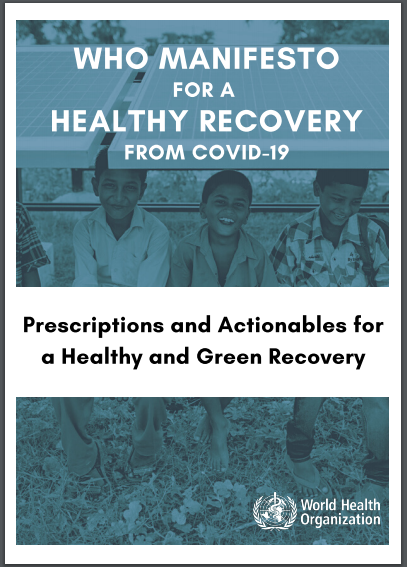Manifesto prescription 2: Invest in essential services, from water and sanitation to clean energy in healthcare facilities.
Around the world, billions of people lack access to the most basic services that are required to protect their health, whether from COVID-19, or any other risk. Handwashing facilities are essential for the prevention of infectious disease transmission, but are lacking in 40 % of households. Antimicrobial-resistant pathogens are widespread in water and waste and their sound management is needed to prevent the spread back to humans. In particular it is essential that health care facilities be equipped with water and sanitation services, including the soap and water that constitutes the most basic intervention to cut transmission of SARS-CoV-2 and other infections, access to reliable energy that is necessary to safely carry out most medical procedures, and occupational protection for health workers.
Overall, avoidable environmental and occupational risks cause about one quarter of all deaths in the world. Investment in healthier environments for health protection, environmental regulation, and ensuring that health systems are climate resilient, is both an essential guardrail against future disaster, and offers some of the best returns for society. For example, every dollar that was invested in strengthening the US Clean Air Act has paid back 30 dollars in benefit to US citizens, through improved air quality and better health.
Actionables
Water
- Provide and promote the use of safe drinking water in communities, schools, health care facilities, workplaces and public places.
- Ensure implementation of drinking-water quality regulations and standards.
- Protect drinking-water supplies using Water Safety Plans (WSPs).
- Include safe and sustainable drinking water, sanitation and hygiene in relevant health policies, strategies and programmes.
Sanitation
- Implement sanitation safety planning.
- Support households to incrementally improve their sanitation facilities to meet minimum safety requirements.
- Promote access to safe toilets in schools, health care facilities, workplaces and public places.
- Avoid open defecation and adopt safe sanitation facilities.
- Promote and support the installation of handwashing facilities in homes and institutions such as schools, workplaces and health care facilities.
- Enforce handwashing facilities in public places, food establishments and markets, and include them in routine inspection and monitoring schemes.
- Make soap and water available to households, institutions and public places. Handwashing facilities with soap and water should be available close to (usually within 5 m) sanitation facilities.
- Promote washing hands with soap at critical times, such as after defecation, after child cleaning and before preparing food.
Clean Energy
- Provide and use clean and safe cooking, heating and lighting solutions.
- Replace traditional household solid fuel stoves with lower-emission cookstoves that are as clean as possible.
- Improve energy efficiency of household appliances, buildings, lighting, heating and cooling.
- Encourage electrification using renewable sources such as solar-, hydro- and wind-based electricity.
Healthy, safe and resilient workplaces for all
- Implement national policies and action plans on occupational safety and health.
- Scale up coverage with essential interventions and basic occupational health services of all workers for primary prevention of occupational and work-related diseases and injuries and promote healthier and safer workplaces, including for migrant and contractual workers and those in the informal economy
- Build workplace resilience to public health emergencies and outbreaks of infectious diseases in all economic sectors.
Additional Actionables specific to health care facilities
- Implement or strengthen Infection Prevention and Control (IPC) in health care facilities through a range of occupational health and patient safety measures.
- Ensure availability of sufficient and safe water at all times for drinking, food preparation, personal hygiene, medical activities, cleaning and laundry.
- Ensure safety of water for drinking, cooking, personal hygiene, medical activities, cleaning and laundry for the purpose intended.
- Provide sufficient water-collection points and water-use facilities in the health care setting to allow convenient access to, and use of, water for medical activities, drinking, personal hygiene, food preparation, laundry and cleaning.
- Provide adequate, accessible and appropriate toilets for patients, staff and carers.
- Ensure rapid and safe wastewater disposal.
- Ensure safe segregation, collection, transportation, storage, treatment and disposal of health care waste.
- Promote correct use of water, sanitation and waste facilities.
- Develop national programmes and healthcare facility policies on occupational health for health workers.
- Build capacities to ensure occupational safety and health and work improvements of health workers and other workers, including in public health emergencies.
- Build and renovate healthcare facilities in an environmentally responsible, climate resilient and sustainable way.
- Consider as much as possible options for waste minimization, environmentally preferable purchasing and green procurement, and safe reuse, recycling and recovery.


